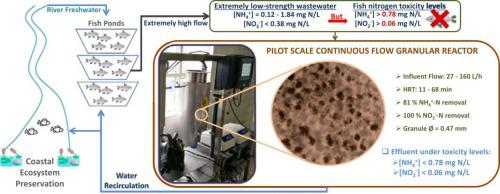Journal of Environmental Chemical Engineering ( IF 7.4 ) Pub Date : 2022-01-21 , DOI: 10.1016/j.jece.2022.107247 S. Santorio 1 , A. Val del Rio 1 , C.L. Amorim 2 , L. Arregui 3 , P.L.M. Castro 1, 2, 3 , A. Mosquera-Corral 1

|
To avoid toxic ammonium and nitrite concentrations in aquaculture systems is crucial to maintain the fish production. When recirculating aquaculture systems (RAS) operate in freshwater farms during the dry seasons, the concentrations of these pollutants increase. The objective of the present study is the evaluation of a Continuous Flow Granular Reactor (CFGR) for the treatment of freshwater RAS stream at pilot-scale during two consecutive dry seasons. The CFGR was fed with a extremely low-strength recirculation stream of a trout farm (0.12 - 1.84 mg NH4+-N/L and 2.2 - 8.14 mg C/L). Two different configurations were evaluated. The first configuration consisted on a CFGR fed from the bottom, being the up-flow velocity the only shear force to mix the biomass. The second configuration incorporated a mechanical stirrer and a sieve to improve the biomass mixing and retention. The CFGR was operated at short hydraulic retention times (HRT) which ranged from 11 to 68 min. The configuration with a mechanical stirrer and sieve was optimal in terms of biomass retention and nitrogen removal performance. Despite the low nitrogen and organic matter concentrations, granulation was achieved in 55 days, with an average granule diameter up to 0.47 mm. Ammonium and nitrite removal percentages up to 81 and 100% were achieved, respectively. The ammonium and nitrite production rate in the trout farm were lower than the removal achieved by the CFGR, which makes the implementation of this system appropriated to maintain the concentration of these compounds below toxic levels for rainbow trout.
中文翻译:

用于处理极低强度循环水养殖系统废水的中试连续流动颗粒反应器
避免水产养殖系统中的有毒铵和亚硝酸盐浓度对于维持鱼类生产至关重要。当循环水产养殖系统 (RAS) 在旱季在淡水养殖场运行时,这些污染物的浓度会增加。本研究的目的是评估连续流动颗粒反应器 (CFGR) 在连续两个旱季期间以中试规模处理淡水 RAS 流。CFGR 采用鳟鱼养殖场的极低强度再循环流(0.12 - 1.84 mg NH 4 + -N/L 和 2.2 - 8.14 mg C/L)。评估了两种不同的配置。第一种配置包括从底部进料的 CFGR,上流速度是混合生物质的唯一剪切力。第二种配置结合了机械搅拌器和筛子,以改善生物质的混合和保留。CFGR 在 11 到 68 分钟的短水力停留时间 (HRT) 下运行。机械搅拌器和筛子的配置在生物质保留和脱氮性能方面是最佳的。尽管氮和有机物浓度较低,但在 55 天内即可实现造粒,平均颗粒直径高达 0.47 毫米。铵和亚硝酸盐的去除率分别达到 81% 和 100%。鳟鱼养殖场中铵和亚硝酸盐的产生率低于 CFGR 实现的去除率,这使得该系统的实施适用于将这些化合物的浓度保持在对虹鳟鱼的毒性水平以下。











































 京公网安备 11010802027423号
京公网安备 11010802027423号